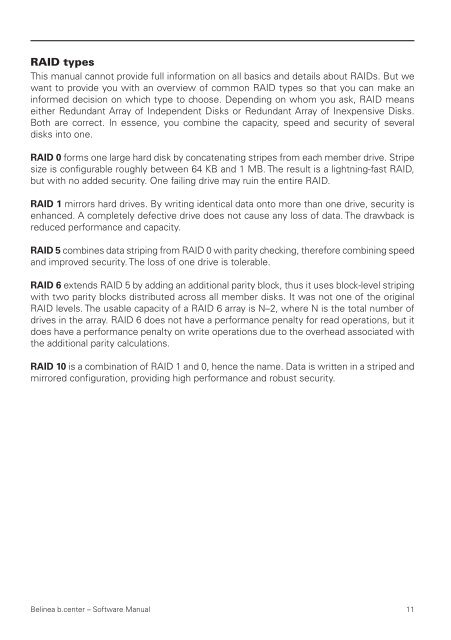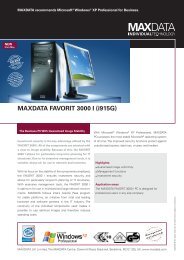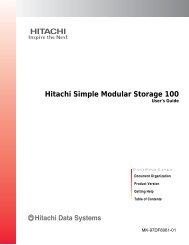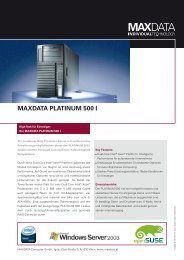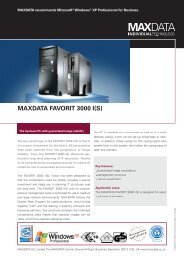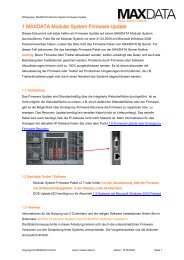- Page 2: Belinea b.centerSoftware ManualbcSU
- Page 8 and 9: Before Getting StartedCongratulatio
- Page 10 and 11: FeaturesThe b.center software is an
- Page 14 and 15: ConfigurationLogging into Belinea b
- Page 16 and 17: Creating a disk arrayIn case you wa
- Page 18 and 19: 3. Log in to the Remote console via
- Page 20 and 21: f. After removing the volumes, the
- Page 22 and 23: Adding a disk array• In the menu,
- Page 24 and 25: Creating b.center sharesIn the menu
- Page 26 and 27: 4. Changing the directory owner:a.
- Page 28 and 29: 9. UNIX Rights in Windows:Folder pe
- Page 30 and 31: Creation of shares and set permissi
- Page 32 and 33: Next, in the “Targets” diagram,
- Page 34 and 35: Description of FunctionsFunctions o
- Page 36 and 37: Function: DNS settingsHere you can
- Page 38 and 39: Function: HTTP proxyWith this funct
- Page 40 and 41: NoteIn case you use an NTP server t
- Page 42 and 43: Function: Administrator passwordUsi
- Page 44 and 45: Function: SSL certificate authority
- Page 46 and 47: To connect to the server from Micro
- Page 48 and 49: Available RAIDs:RAID 0: Stripe arra
- Page 50 and 51: Function: S/W RAID e-mail notificat
- Page 52 and 53: RAID 6:• To set a unit as Faulty,
- Page 54 and 55: Function: Initiator iSCSI nameHere
- Page 56 and 57: HardwareFunction: UPS settingsHere
- Page 58 and 59: Function: Time zone settingsThis fu
- Page 60 and 61: Function: Power button settingsIn t
- Page 62 and 63:
Disk notations:• S0, S1, ..., S[x
- Page 64 and 65:
Function: Volume managerThis functi
- Page 66 and 67:
NoteThe space reserved for snapshot
- Page 68 and 69:
Function: Mirror server IPHere you
- Page 70 and 71:
NAS settingsFunction: Authenticatio
- Page 72 and 73:
Note1. Workgroup name cannot begin/
- Page 74 and 75:
How to enter IP addressesIn order t
- Page 76 and 77:
Hide special foldersThis option hid
- Page 78 and 79:
Allow access IPList of IP addresses
- Page 80 and 81:
NoteUnder certain conditions, the w
- Page 82 and 83:
Restore:1. From the Quick start men
- Page 84 and 85:
Function: Antivirus setupThis funct
- Page 86 and 87:
NAS resourcesHere, you can configur
- Page 88 and 89:
In order to assign ACL permissions:
- Page 90 and 91:
Belinea b.center - Software Manual8
- Page 92 and 93:
All squashMap all User IDs to nobod
- Page 94 and 95:
In MAC OSX 10.3 (alternative proced
- Page 96 and 97:
Function: Data replication agent se
- Page 98 and 99:
Function: UID mappings (upload/down
- Page 100 and 101:
Function: User groups membershipWhe
- Page 102 and 103:
Function: GID mappings (upload/down
- Page 104 and 105:
iSCSI target managerFunction: Creat
- Page 106 and 107:
Function: Target volume managerThis
- Page 108 and 109:
If you enter a network range in lon
- Page 110 and 111:
Function: Create schedule for shutd
- Page 112 and 113:
SnapshotFunction: Snapshot tasksUsi
- Page 114 and 115:
Function: Snapshot infoHere you can
- Page 116 and 117:
Function: Backup device settingsHer
- Page 118 and 119:
ActionAction that can be performed
- Page 120 and 121:
Function: Create new schedule for b
- Page 122 and 123:
NoteIn order to set a share as dest
- Page 124 and 125:
RestoreFunction: Backup restore tas
- Page 126 and 127:
Every backup task in the results wi
- Page 128 and 129:
Function: Update local virus defini
- Page 130 and 131:
Function: Create new schedule for a
- Page 132 and 133:
Software updateThis function allows
- Page 134 and 135:
Function: DNS infoHere you can view
- Page 136 and 137:
ConnectionsThis function displays a
- Page 138 and 139:
HardwareThe “Hardware” option p
- Page 140 and 141:
Function: Memory (RAM) infoThis fun
- Page 142 and 143:
TasksHere you can view statistical
- Page 144 and 145:
S.M.A.R.T.Through the S.M.A.R.T. (S
- Page 146 and 147:
HELPSoftware LicenseClick on “Hel
- Page 148 and 149:
TroubleshootingHere is a list of co
- Page 150 and 151:
Error: invalid workgroup nameWorkgr
- Page 152 and 153:
MAXDATA Software License AgreementI
- Page 154 and 155:
GNU GENERAL PUBLIC LICENSEVersion 2
- Page 156 and 157:
2. You may modify your copy or copi
- Page 158 and 159:
6. Each time you redistribute the P
- Page 160 and 161:
How to Apply These Terms to Your Ne
- Page 162 and 163:
The PHP License, version 3.01Copyri
- Page 164 and 165:
GNU LESSER GENERAL PUBLIC LICENSEVe
- Page 166 and 167:
TERMS AND CONDITIONS FOR COPYING, D
- Page 168 and 169:
3. You may opt to apply the terms o
- Page 170 and 171:
7. You may place library facilities
- Page 172 and 173:
14. If you wish to incorporate part
- Page 174:
.centerAustriaMAXDATA Computer GmbH


